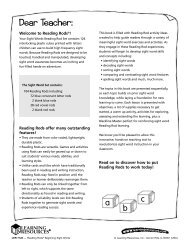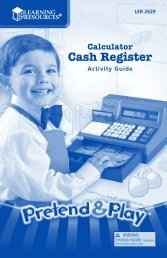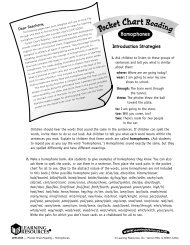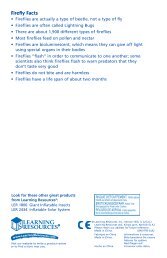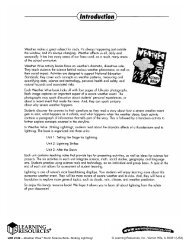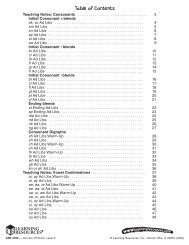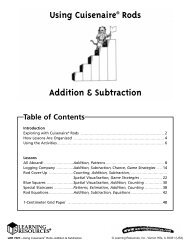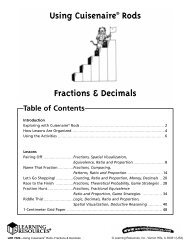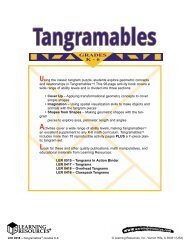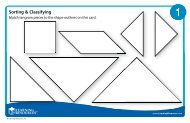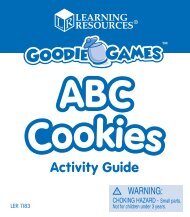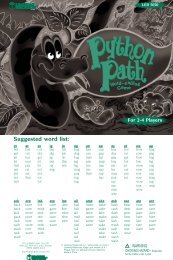Using Cuisenaire® Rods Geometry & Measurement - Learning ...
Using Cuisenaire® Rods Geometry & Measurement - Learning ...
Using Cuisenaire® Rods Geometry & Measurement - Learning ...
You also want an ePaper? Increase the reach of your titles
YUMPU automatically turns print PDFs into web optimized ePapers that Google loves.
© <strong>Learning</strong> Resources, Inc., Vernon Hills, IL 60061 (USA)<br />
<strong>Using</strong> Cuisenaire ® <strong>Rods</strong><br />
<strong>Geometry</strong> & <strong>Measurement</strong><br />
Table of Contents<br />
Introduction<br />
Exploring with Cuisenaire ® <strong>Rods</strong> 2<br />
How Lessons Are Organized 4<br />
<strong>Using</strong> the Activities 6<br />
Lessons<br />
Cover the Camel Counting, Area, Spatial Visualization 8<br />
You’ll Be “Floored”! Area, Spatial Visualization,<br />
Comparing, Equivalence 14<br />
An Amusing Adventure Estimation, Mental Math 22<br />
Getting Triangular<br />
Properties of Triangles,<br />
Mental Computation, Patterns 30<br />
Mirror, Mirror<br />
Spatial Visualization, Line Symmetry,<br />
Rotational Symmetry 36<br />
Can You Build It<br />
Following Directions, Spatial Visualization,<br />
Properties of Geometric Figures 42<br />
1-Centimeter Grid Paper 48<br />
LER 7530 — <strong>Geometry</strong> & <strong>Measurement</strong> — Grades 3-6
© <strong>Learning</strong> Resources, Inc., Vernon Hills, IL 60061 (USA)<br />
®<br />
Exploring with Cuisenaire <strong>Rods</strong><br />
A versatile collection of 10 colored rectangular rods, Cuisenaire ® <strong>Rods</strong> are used to develop a variety of<br />
math skills. Each rod’s color corresponds to a different length. The shortest rod, the white, is<br />
1 centimeter long; the longest, the orange, is 10 centimeters long. When the rods are arranged in order<br />
of length into a pattern commonly called a “staircase,” each rod differs from the next by 1 centimeter.<br />
This allows you to assign a value to one rod and then assign values to the other rods based on the relationships<br />
between the rods. One set contains 74 rods, distributed in the quantities shown below. The<br />
10 colors are referred to as follows:<br />
o<br />
e<br />
n<br />
k<br />
d<br />
y<br />
p<br />
g<br />
r<br />
w<br />
w<br />
o = orange (4) y = yellow (4)<br />
w<br />
e = blue (4) p = purple (6)<br />
w<br />
n = brown (4) g = light green (10)<br />
w k = black (4) r = red (12)<br />
w d = dark green (4) w = white (22)<br />
w<br />
o<br />
e<br />
w<br />
n<br />
k w<br />
d<br />
y<br />
p<br />
w<br />
g w<br />
r<br />
w<br />
<strong>Using</strong> letters to represent the rods exposes students to the kind of symbolic thinking they will use later<br />
in algebra.<br />
With Cuisenaire <strong>Rods</strong>, students can explore spatial relationships by making flat designs on a table<br />
or by stacking them to make three-dimensional designs. They soon discover how some combinations<br />
of rods are equal in length to other, single rods. This understanding provides a context for<br />
investigating symmetry.<br />
Older students may focus on comparing the lengths of the rods and recording the results on grid<br />
paper. This helps them visualize the inherent “structure” of a design and gives them practice using<br />
grade-appropriate arithmetic and geometric vocabulary. Though students need to explore freely,<br />
some may appreciate specific challenges, such as being asked to make designs that show fractional<br />
equivalence between two groups of rods.<br />
Working with Cuisenaire <strong>Rods</strong><br />
Cuisenaire <strong>Rods</strong> provide a basic model for the<br />
numbers 1 to 10. The white rod can stand for 1,<br />
and the red rod can stand for 2, because the<br />
red rod is the same length as a “train” of two<br />
white rods. The rods from light green through<br />
orange are assigned values from 3 through<br />
10, respectively.<br />
The orange and white rods provide a model for<br />
place value. A “train” of 4 orange rods (“tens”)<br />
and 3 white rods (“ones”) is 43 white rods long.<br />
LER 7530 — <strong>Geometry</strong> & <strong>Measurement</strong> — Grades 3-6
© <strong>Learning</strong> Resources, Inc., Vernon Hills, IL 60061 (USA)<br />
<strong>Using</strong> the Activities<br />
Strands and Skills<br />
Problem Solving<br />
Reasoning & Proof<br />
Communication<br />
Connections<br />
Representation<br />
Number &<br />
Operations<br />
Algebra<br />
<strong>Geometry</strong><br />
Counting<br />
Comparing<br />
Equivalence<br />
Estimation<br />
Patterns<br />
Properties of<br />
Geometric Figures<br />
Area & Perimeter<br />
<strong>Measurement</strong><br />
Spatial Visualization<br />
Symmetry<br />
Cover the Camel<br />
You’ll Be “Floored”!<br />
An Amusing Adventure<br />
Getting Triangular<br />
• • • • • •<br />
• • • • • •<br />
• • • • • •<br />
• • • • • •<br />
• • • • • •<br />
• •<br />
•<br />
•<br />
•<br />
•<br />
• • •<br />
• •<br />
• • •<br />
• • • • • •<br />
•<br />
Mirror, Mirror<br />
Can You Build It<br />
Are You <strong>Using</strong> the Super Source ® <br />
If you are currently using the Super Source ® , available from<br />
ETA/Cuisenaire ® , with your Cuisenaire ® <strong>Rods</strong>, you can use<br />
the activities in <strong>Using</strong> Cuisenaire ® <strong>Rods</strong>: <strong>Geometry</strong> &<br />
<strong>Measurement</strong> for additional practice. This chart correlates<br />
the activities in both books:<br />
<strong>Using</strong> Cuisenaire <strong>Rods</strong><br />
the Super Source<br />
Cover the Camel<br />
You’ll Be “Floored”!<br />
An Amusing Adventure<br />
Getting Triangular<br />
Mirror, Mirror<br />
Can You Build It<br />
Cover the Giraffe, Book K–2<br />
Tiling with <strong>Rods</strong>, Book 3–4<br />
Tour of the Islands, Book 3–4<br />
Making Triangles, Book 5–6<br />
Place the Mirror, Book 5–6<br />
Building to Spec, Book 3–4<br />
LER 7530 — <strong>Geometry</strong> & <strong>Measurement</strong> — Grades 3-6
© <strong>Learning</strong> Resources, Inc., Vernon Hills, IL 60061 (USA)<br />
3<br />
An Amusing Adventure<br />
Getting Started<br />
Supplies<br />
Cuisenaire ® <strong>Rods</strong>, 1 set per<br />
group<br />
Amusement Park Map to be<br />
taped together, 1 per group,<br />
pages 26–29<br />
Crayons<br />
1 centimeter ruler, for<br />
“Student Starters”<br />
Numbers • <strong>Measurement</strong><br />
Estimation • Mental Math<br />
A Look Ahead<br />
In this game for two to four players, students<br />
estimate distances on a map in<br />
terms of centimeters or as a combination<br />
of various Cuisenaire <strong>Rods</strong>. They then<br />
check their estimates by making rod trains<br />
on the map.<br />
<strong>Learning</strong> Objectives<br />
In this activity, students have the opportunity<br />
to:<br />
• estimate and measure with centimeters<br />
• do mental computation<br />
• strengthen their number sense<br />
The Activity<br />
Student Starters<br />
Explain to students that Cuisenaire <strong>Rods</strong><br />
can be used to measure distances in terms<br />
of centimeters. Hold a white rod against a<br />
centimeter ruler to show that the white<br />
rod is one centimeter long. Ask students to<br />
determine the lengths of the other rods in<br />
centimeters.<br />
• Challenge pairs of students to each place<br />
their two index fingers 9 centimeters<br />
apart on a desktop. Have them check<br />
their estimates with a blue rod.<br />
• Ask students: “Which rods can you use<br />
to check longer distances, such as<br />
20 centimeters” Accept any reasonable<br />
answers, such as using a two-car orange<br />
train or two blue rods plus a red rod.<br />
• Have students use their index fingers<br />
on the desktop to estimate distances<br />
between 1 and 30 centimeters and<br />
check their estimates with rods.<br />
• Explain the rules for this game, An<br />
Amusing Adventure, as described in the<br />
“Independent Exploration.” Show how to<br />
attach the four parts of the map to make<br />
up the gameboard. Then select a student<br />
to play part of a sample game with you.<br />
LER 7530 — <strong>Geometry</strong> & <strong>Measurement</strong> — Grades 3-6
© <strong>Learning</strong> Resources, Inc., Vernon Hills, IL 60061 (USA)<br />
Numbers • <strong>Measurement</strong><br />
Estimation • Mental Math<br />
Independent Exploration<br />
An Amusing Adventure 3<br />
Play An Amusing Adventure!<br />
1. This is a game for two to four players. The object is to be the first to land on each of the rides on the map,<br />
and then return to the Arcade.<br />
2. You will be playing on a map that shows the Arcade and 10 amusement<br />
park attractions. Each player must choose a different-colored<br />
crayon to record his or her plays. Decide who goes first.<br />
3. The first player draws an X anywhere on the Arcade to mark a starting<br />
point and decides which attraction to visit first.<br />
4. That player announces an estimate of the distance from the starting<br />
point to the ride. Then, starting at the X, the player places a train of<br />
rods equal to his or her estimate in the direction of the first ride, and<br />
marks where the train ends. If the train reaches the ride, on the next<br />
turn the player can proceed in the same way to any other ride from the<br />
ride he or she is visiting. If the train does not reach the ride, the player<br />
must “wait in line” and try to reach the ride from this location on his<br />
or her next turn.<br />
5. Taking turns, each player chooses a different starting point at the<br />
Arcade, marks it with an X, and follows the same procedure to go from ride to ride in any order. Track who<br />
visits which ride first on a piece of paper<br />
6. When players have visited all of the rides, they use the same procedure to return to their starting point at<br />
the Arcade from the last ride. The player who returns to the starting point first is the winner.<br />
7. Play the game several times. Visit the rides in a different order each time.<br />
Beyond the Activity<br />
Discussion Points<br />
Invite students to talk about their games<br />
and describe their thoughts during the<br />
game. Use prompts, such as these, to promote<br />
class discussion:<br />
• Did you get better at estimating as you<br />
played Explain.<br />
• Was it easier to accurately estimate short<br />
distances or long distances Why<br />
• What tips could you give classmates who<br />
want to improve their estimating<br />
• Which is the most efficient route That is,<br />
which route allows you to visit all six<br />
rides and return to the Arcade in the<br />
shortest number of centimeters<br />
Extensions<br />
1. Have students design their own<br />
Amusing Adventure gameboard maps<br />
with a playground or schoolyard theme,<br />
and play the game again on their maps.<br />
2. Have students keep a running total of<br />
the number of centimeters they "travel"<br />
in their tour. The winner might then be<br />
the player who takes either the longest<br />
or shortest tour.<br />
3. Have students play the game again. This<br />
time, players must find the shortest distance<br />
in centimeters from the Arcade<br />
and back, visiting all the rides except the<br />
two roller coasters at the park.<br />
LER 7530 — <strong>Geometry</strong> & <strong>Measurement</strong> — Grades 3-6
© <strong>Learning</strong> Resources, Inc., Vernon Hills, IL 60061 (USA)<br />
3<br />
An Amusing Adventure<br />
Teaching Notes<br />
Numbers • <strong>Measurement</strong><br />
Estimation • Mental Math<br />
Mathematics in Action<br />
An Amusing Adventure is an engaging way to practice estimation skills and develop better<br />
number sense. Many students’ estimation skills improve noticeably while playing this game.<br />
These students form a mental image of one of the Cuisenaire ® <strong>Rods</strong>, such as the orange, and<br />
then use it as a benchmark for making their estimates. Students visualize reaching the desired<br />
goal using the chosen rod, thereby improving their estimation skills. Some students report that<br />
they used the measurements they made earlier in the game to help them estimate new distances.<br />
For example, if they found that the distance from the Arcade to the carousel is<br />
28 centimeters and the distance to the balloons from the carousel looks about half as far, they<br />
may estimate that the second distance would measure 28 - 14, or 14 centimeters.<br />
Students report that shorter rather than longer distances are easier to estimate. For example,<br />
they might try to estimate a longer distance by mentally making a train of orange rods, and<br />
then make a mistake in their visualization of the length of the orange rod. The mistake then<br />
becomes compounded. Shorter distances, however, require that students<br />
visualize the lengths of only one or two rods, so potential mistakes tend<br />
to be minimized.<br />
After making an estimate, students need to figure out a train of rods with<br />
a length that equals that estimate. Many students will use multiplication,<br />
thinking, “I have estimated 20 centimeters, which could be 4 times 5, or<br />
4 yellow rods.” Others will think in terms of place value: “I have estimated<br />
23 centimeters, which would be 2 orange (10-centimeter) rods and 3 white<br />
(1-centimeter) rods.”<br />
LER 7530 — <strong>Geometry</strong> & <strong>Measurement</strong> — Grades 3-6
© <strong>Learning</strong> Resources, Inc., Vernon Hills, IL 60061 (USA)<br />
Numbers • <strong>Measurement</strong><br />
Estimation • Mental Math<br />
An Amusing Adventure 3<br />
Teaching Notes<br />
Still other students will pick up a combination of rods that add up to the given number:<br />
“I have estimated 17 centimeters, which could be a blue (9) plus a brown (8).”<br />
Sometimes students use subtraction as well, reasoning, “I have estimated 39 centimeters,<br />
which is almost 40, so if I put down 4 orange rods and then count back one white<br />
rod, it will be the same as 39.”<br />
Observing how their teammates use the rods to check their estimates will give students<br />
different strategies for thinking about numbers.<br />
New Challenges<br />
Students enjoy devising ways to make the game more challenging. Some may suggest<br />
making the rides smaller and farther apart. A smaller ride makes<br />
a smaller target, and longer distances are harder to estimate. Some combine<br />
the idea of smaller rides with the idea of more rides so that they must make more stops.<br />
Some students may suggest hiding the rods while the estimate is being made so that<br />
players do not have a visual way of checking their measurements. A few students may<br />
suggest keeping track of their estimates on a separate piece of paper and adding them<br />
to find the total distance of the trip. Then, the one with the longest (or shortest, depending<br />
on their pre-game agreement) trip wins.<br />
Some will add details, such as snack booths, that must be avoided,<br />
challenging players to route their travels around these hazards.<br />
Still others add rewards (like a balloon) so that if a<br />
player lands exactly on one of these rewards, he or she is<br />
rewarded with an extra turn or the chance to skip to<br />
the next ride without estimating. The variations are<br />
limited only by the creativity of the students.<br />
LER 7530 — <strong>Geometry</strong> & <strong>Measurement</strong> — Grades 3-6
© <strong>Learning</strong> Resources, Inc., Vernon Hills, IL 60061 (USA)<br />
3<br />
An Amusing Adventure<br />
Amusement Park Map<br />
(Northwest Section)<br />
Numbers • <strong>Measurement</strong><br />
Estimation • Mental Math<br />
Train Ride<br />
Carousel<br />
Splash Slide<br />
LER 7530 — <strong>Geometry</strong> & <strong>Measurement</strong> — Grades 3-6
© <strong>Learning</strong> Resources, Inc., Vernon Hills, IL 60061 (USA)<br />
Numbers • <strong>Measurement</strong><br />
Estimation • Mental Math<br />
An Amusing Adventure 3<br />
Amusement Park Map<br />
(Northeast Section)<br />
Funhouse<br />
Balloons!<br />
Rock & Roller<br />
LER 7530 — <strong>Geometry</strong> & <strong>Measurement</strong> — Grades 3-6
© <strong>Learning</strong> Resources, Inc., Vernon Hills, IL 60061 (USA)<br />
3<br />
An Amusing Adventure<br />
Amusement Park Map<br />
(Southwest Section)<br />
Numbers • <strong>Measurement</strong><br />
Estimation • Mental Math<br />
Big Dipper<br />
Around the Whirl<br />
ARCADE<br />
LER 7530 — <strong>Geometry</strong> & <strong>Measurement</strong> — Grades 3-6
© <strong>Learning</strong> Resources, Inc., Vernon Hills, IL 60061 (USA)<br />
Numbers • <strong>Measurement</strong><br />
Estimation • Mental Math<br />
An Amusing Adventure 3<br />
Amusement Park Map<br />
(Southeast Section)<br />
Ferris Wheel<br />
Tickets<br />
Tickets<br />
ARCADE<br />
LER 7530 — <strong>Geometry</strong> & <strong>Measurement</strong> — Grades 3-6



